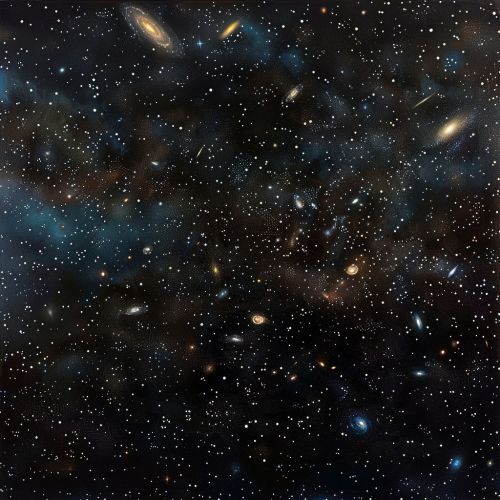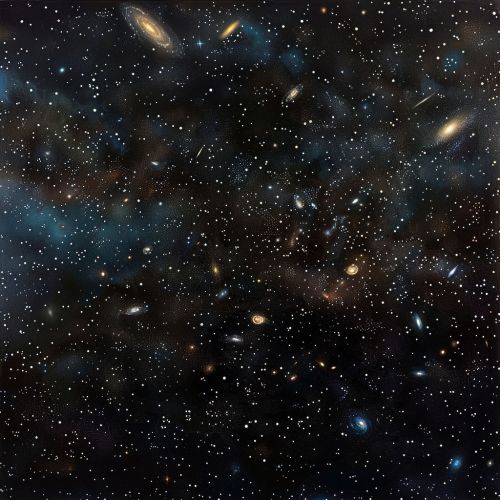Big Freeze
Overview
The term "Big Freeze" refers to a theoretical scenario concerning the ultimate fate of the universe. This hypothesis posits that the universe will continue to expand indefinitely, leading to a state where all thermodynamic activity ceases, resulting in a cold, dark, and lifeless cosmos. The Big Freeze is one of several possible outcomes for the universe, alongside the Big Crunch and the Big Rip.
Cosmological Background
The concept of the Big Freeze is rooted in the principles of cosmology, the scientific study of the large-scale properties of the universe as a whole. Central to this discussion is the Second Law of Thermodynamics, which states that the total entropy of an isolated system can never decrease over time. As the universe expands, it becomes increasingly disordered, and its energy becomes more evenly distributed.
The Big Freeze scenario is closely linked to the cosmological constant, a term introduced by Albert Einstein in his field equations of general relativity. The cosmological constant is associated with the energy density of empty space, or dark energy, which is believed to drive the accelerated expansion of the universe.
Mechanisms of Expansion
The expansion of the universe is described by the Friedmann equations, which are derived from Einstein's field equations. These equations take into account the density of matter, radiation, and dark energy in the universe. Observations of distant supernovae and the cosmic microwave background (CMB) radiation have provided strong evidence for the accelerated expansion driven by dark energy.
As the universe expands, galaxies move away from each other, and the space between them increases. This expansion is not uniform; it is influenced by the distribution of matter and energy. Over time, the density of matter decreases, and the influence of dark energy becomes more dominant.
Stages of the Big Freeze
The Big Freeze can be divided into several stages, each characterized by different physical processes and timescales:
Stellar Era
In the current epoch, known as the Stellar Era, stars are the primary sources of energy. Nuclear fusion within stars converts hydrogen into helium, releasing energy in the form of light and heat. This era will continue for approximately 10^14 years, after which most stars will have exhausted their nuclear fuel.
Degenerate Era
Following the Stellar Era, the universe will enter the Degenerate Era, lasting from 10^14 to 10^40 years. During this period, the remnants of stars, such as white dwarfs, neutron stars, and black holes, will dominate. These objects will gradually cool and fade, and the universe will become increasingly dark.
Black Hole Era
The Black Hole Era will span from 10^40 to 10^100 years. During this time, black holes will be the primary constituents of the universe. They will slowly evaporate through Hawking radiation, a quantum mechanical process predicted by Stephen Hawking. As black holes lose mass, they will eventually disappear, leaving behind a sparse distribution of elementary particles.
Dark Era
The final stage, known as the Dark Era, will begin after 10^100 years and continue indefinitely. In this era, the universe will consist of a dilute gas of photons, neutrinos, electrons, and positrons. The temperature of the universe will approach absolute zero, and all thermodynamic processes will cease.


Implications for Life and Matter
The Big Freeze has profound implications for the future of life and matter in the universe. As the universe cools and expands, the conditions necessary for life will become increasingly rare. Stars will no longer form, and existing stars will burn out, leading to a universe devoid of light and heat.
The decay of matter is another significant aspect of the Big Freeze. Protons, the building blocks of atomic nuclei, are predicted to decay over extremely long timescales, potentially on the order of 10^34 years. If proton decay occurs, all matter will eventually disintegrate into subatomic particles, further contributing to the universe's entropy.
Observational Evidence
Several lines of observational evidence support the Big Freeze scenario:
Cosmic Microwave Background
The CMB radiation, discovered in 1965 by Arno Penzias and Robert Wilson, provides a snapshot of the early universe. The uniformity and slight anisotropies in the CMB suggest that the universe has been expanding and cooling since the Big Bang.
Supernova Observations
Observations of distant Type Ia supernovae have revealed that the universe's expansion is accelerating. This acceleration is attributed to dark energy, which constitutes approximately 68% of the total energy density of the universe.
Large-Scale Structure
The distribution of galaxies and galaxy clusters on large scales provides insights into the universe's expansion history. The Lambda-CDM model, which includes dark energy (represented by the cosmological constant) and cold dark matter, accurately describes the observed large-scale structure and supports the Big Freeze scenario.
Theoretical Considerations
The Big Freeze is a consequence of several fundamental theories in physics:
General Relativity
Einstein's theory of general relativity describes the gravitational interaction between matter and energy. The field equations of general relativity, which include the cosmological constant, predict the accelerated expansion of the universe.
Quantum Mechanics
Quantum mechanics plays a crucial role in understanding the behavior of particles and fields in the universe. The concept of Hawking radiation, which leads to the evaporation of black holes, is a result of the interplay between quantum mechanics and general relativity.
Thermodynamics
The Second Law of Thermodynamics, which governs the increase of entropy, is central to the Big Freeze scenario. As the universe expands and cools, its entropy increases, leading to a state of maximum disorder and minimal energy availability.
Alternative Scenarios
While the Big Freeze is a widely accepted hypothesis, other scenarios for the universe's ultimate fate have been proposed:
Big Crunch
The Big Crunch posits that the universe's expansion will eventually reverse, leading to a contraction and a final collapse. This scenario requires a sufficient amount of matter to overcome the repulsive force of dark energy.
Big Rip
The Big Rip suggests that the expansion of the universe will accelerate to the point where all structures, from galaxies to atoms, are torn apart. This scenario depends on the properties of dark energy, specifically whether its density increases over time.
Conclusion
The Big Freeze represents a compelling and scientifically grounded hypothesis for the ultimate fate of the universe. It is supported by a wealth of observational evidence and theoretical considerations. As our understanding of cosmology and fundamental physics continues to advance, the Big Freeze scenario may be further refined or challenged by new discoveries.
